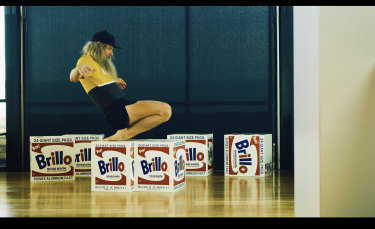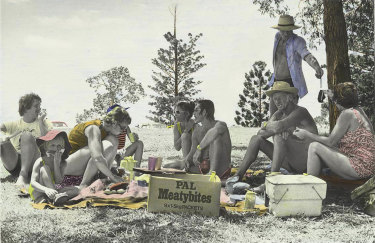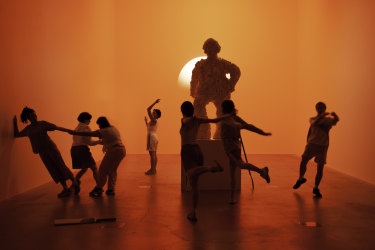
Shaun Gladwell: Homo Suburbiensis

Shaun Gladwell, Homo Suburbiensis, 2020, (still). Cinematographer: Skye DaviesCredit:© Shaun Gladwell. Courtesy the artist & Anna Schwartz Gallery
In perpetually interrogating human movement, it seems natural that Shaun Gladwell should conflate his running and his art. Gladwell’s newest work features elongated oil paintings, referencing subjects from the Beastie Boys to paint packaging – and these connect to the video Homo Suburbiensis. The 13-minute work shows Gladwell – known for videos capturing skateboarders and surfers in suspended moments – running throughout Melbourne; manoeuvring a BMX on a benchtop; stretching across Andy Warhol’s Brillo Boxes; eating McDonald’s with curiosity; taking apart a computer; being confused by VR; and dancing in the street with clubbing youths. It supposedly points to both the fallibility and potential of movement, but the human freedom it’s grasping for feels more like a simulation of freedom. This is all overlaid with documentary-like narration, which partly lifts from Danish filmmaker Jorgen Leth’s short film The Perfect Human (1967). There are many cultural references in Homo Suburbiensis, and a habit of Gladwell’s is that he overplays his influences by making them allusions to merely notice. The implicit boyish masculinity in his work is something I find difficult to enter, and what has compelled me towards Gladwell’s past videos is not the lauded contemporariness, but something more conservative: the unexpected beauty. Here, that’s difficult to locate.
Until April 24; Anna Schwartz Gallery, 185 Flinders Lane, CBD, 9654 6131, annaschwartzgallery.com
Ruth Maddison: It Was the Best of Times, It Was the Worst of Times

Ruth Maddison, Untitled #18, 1979, from the series Christmas holidays with Bob’s family. Mermaid Beach, Queensland 1979. Credit:Courtesy of the artist and the Centre for Contemporary Photography
By distinctly illustrating the intimate and political power of images, photographer Ruth Maddison gives brilliant, delicate life to photography as art, social documentary and historical evidence. Maddison was 30 when she picked up a camera in 1976, and this survey traces her preoccupations over the decades; capturing personalities of Australia’s cultural nexus (Helen Garner, Jenny Watson and Stephen Cummings are here), photographing the visceral demands and hopes of activist protests, and showing the everydayness of women in the workforce. In tasteful and poignant images, Maddison captures the social and economic rhythms of Eden, a small town on the New South Wales coast she moved to in 1996. The show’s final section is unexpected yet flooring: through archival texts and images, interwoven with Maddison’s work, it focuses on the communist activities of her father, Sam Goldbloom, who was under ASIO surveillance for years; Maddison only discovered the full story of his life recently. In witnessing time unfold and suspend itself across hundreds of images – whether black and white, hand-coloured or collaged – she makes apparent that cameras are not neutral observers but instead await the photographer’s gaze. In Maddison’s case, it is a very empathic, yet highly shrewd, gaze.
Until April 18; Centre for Contemporary Photography, 404 George St, Fitzroy, 9417 1549, ccp.org.au
Amrita Hepi: Monumental

Amrita Hepi, Monumental.






 Add Category
Add Category